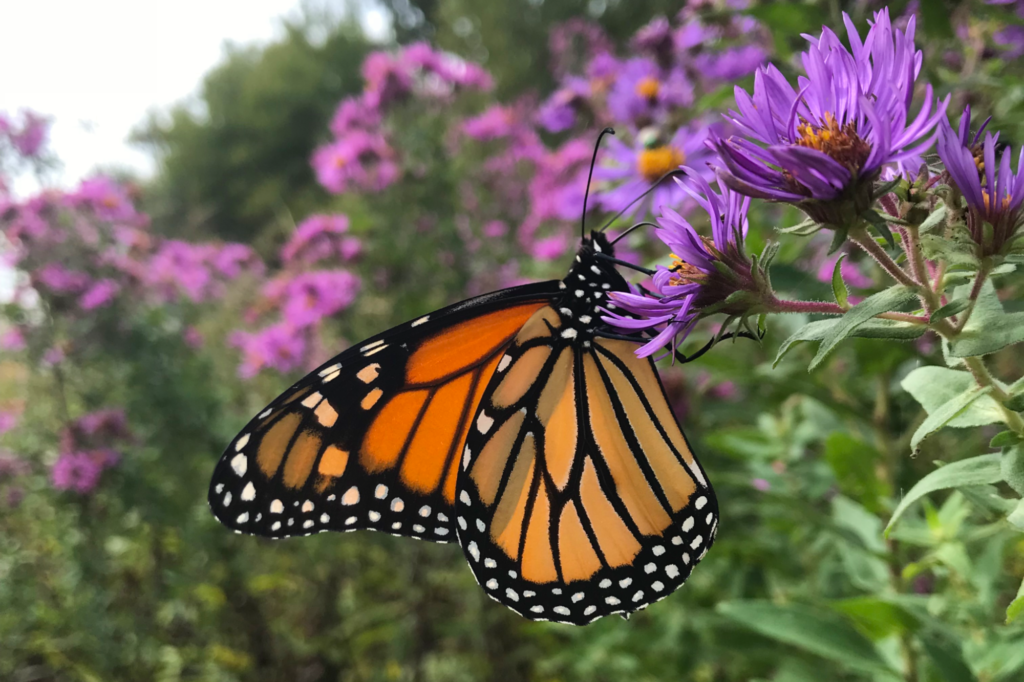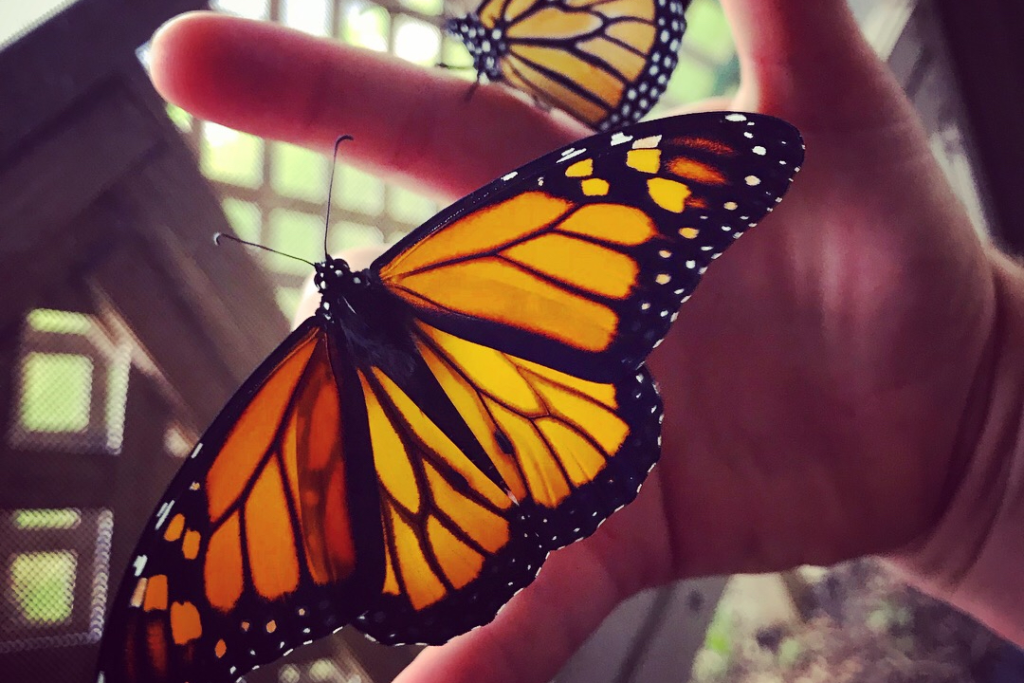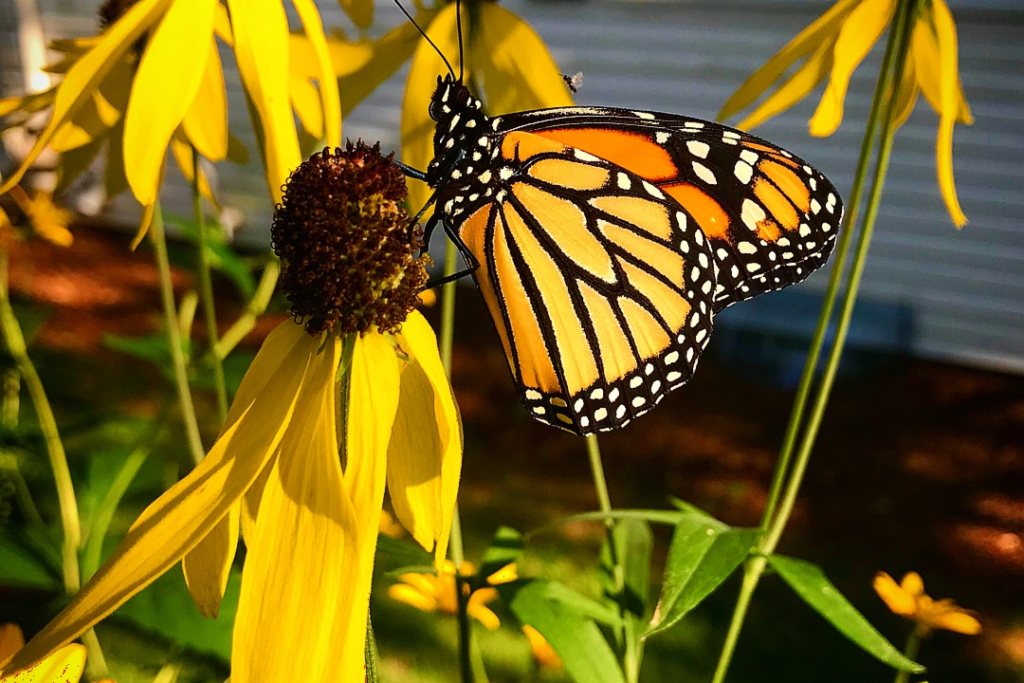
The warmth of summer brings a special friend to Wisconsin: the monarch butterfly!
Over the past few years, my family and students have loved helping the monarch butterfly population survive and thrive. Collecting eggs and seeing them hatch is like a fantastic treasure hunt. Watching the caterpillars molt and grow offers new surprises each day they are with us. The J-hang is the signal that the most exciting part of the cycle (at least in my house) is about to happen! And then the glory of eclosure from the chrysalis feels like a sweet reward. Finally, the release and fond farewell to our winged friends!
Raising and caring for monarch butterflies has become a part of our summer days. This summer, give it a try with your own family!
EGG HUNT
Monarch butterflies rely completely on the milkweed plant for survival. Milkweed is the food for growing monarch caterpillars, and therefore it is where mama monarchs lay their eggs so new hatchlings have a food source immediately upon hatching. This is where your egg hunt begins! Look on milkweed plants for the tiny, white, ridged eggs. Often on the underside of leaves, but we have found eggs all over on milkweed plants. Sometimes we will even spot a laying mama and try to follow her! When you find an egg, you can remove the leaf or part of the leaf and place it in a clean, lidded container. Usually, where there is one egg, more are to be found! Back at home, keep the eggs on their leaves in a safe location — away from larger caterpillars, secure from sneaking away from their food source. Then it’s time to watch for your eggs to hatch.
RAISING CATS
When caterpillars first hatch, they are smaller than a grain of rice! They are fun to watch chew their way out of the egg, especially with a pocket microscope or even just the zoom on a phone’s camera screen. Keep the tiny caterpillars in the same secure container (we use small plastic storage containers so they don’t get lost) with some healthy milkweed. Check on them twice a day to get a little air moving in there and ensure milkweed is moist and healthy.
The caterpillars will grow and molt — shedding their skin as they outgrow it. Each time this happens, they become a new instar (a phase between periods of molting), growing from one instar to five instar. You may find molted skin from larger caterpillars, or maybe even catch a caterpillar eating their own old skin!
Once the caterpillars are easy to spot — about two instar — we move them into a mesh habitat with a large clipping of milkweed in covered water. We use floral water tubes or covered containers with a hole for the stem punctured in the top. Caterpillars can fall into open water and drown, so we always keep our water covered and clean. Add and change milkweed as needed. Keep the habitat clean — caterpillars make a lot of frass (poop!) that needs to be cleared out to keep everyone healthy. Caterpillars will move all around the habitat. We always open the habitat carefully in case any caterpillars are camped out on the zipper.
Once the caterpillars are big (five instar) they will climb to the top of the habitat, build their cremaster (a black stem on a white button of silk, from which they will hang) and start their J-hang, named for the shape their bodies take.

CHRYSALIS, NOT COCOON!
Monarch butterflies — and all butterfly species — pupate into an adult butterfly in a chrysalis. Usually the morning after a caterpillar has been in their J-hang, the transformation happens. Seeing this process the most exciting part. My family will sit and watch with more dedication than we give to Netflix or Disney+! The caterpillar’s black, white and yellow striped skin will begin to split and reveal a bright green blob. This is the beginning of the chrysalis. The first twenty-four hours after pupation are the most critical — leave it alone without any bumps or nudges. After a week or so, the chrysalis will begin to turn black and then clear, revealing the orange and black wings inside. The butterfly will begin to crawl out of the cracking chrysalis shell, and hang upside down for several hours to let their wings expand and dry. There is often a brown fluid that drips down. This is totally normal and doesn’t require any intervention. After the butterfly has a chance to dry and test their wings, we release them to the sunny, warm day and watch them fly off!
TRACKING MONARCHS
Because we grow fond of our friends, my family gives our monarchs names during their time with us. We use those names to track the number of releases we have in any given year. There are more scientific ways to track monarchs as well. There are several active volunteer groups, like Journey North and Monarch Watch, who tag monarch butterflies and track their migration journeys down to their winter homes in Mexico. Groups around Wisconsin usually invite families to come out to prairies and other monarch locations to help tag the butterflies in late summer. Or you can request tags of your own to attach to the monarchs you raise and release.

And here are some other ways to enjoy monarch-inspired fun and learning:
MONARCH ART
There is already so much learning and excitement around the whole process of witnessing the monarch life cycle, but we love to add in some additional enrichment in the way of monarch art. Draw each phase of the life cycle. Paint what you would look like as a butterfly. Create your own butterfly wings to wear. Sketch a milkweed plant. Get creative!
MONARCH BOOKS
A Butterfly is Patient by Dianna Hutts Aston
This gorgeous nonfiction book takes readers on a journey through the life cycles, habitats and behaviors of many different types of butterflies. The engaging illustrations will keep your explorers coming back to learn more.
Gotta Go! Gotta Go! by Sam Swope
This sweet story accurately describes and depicts the life cycle and travels of the monarch butterflies. The story is so charming and fun that it is easy to forget how much little bookworms will learn while laughing at the silly rhymes.
– Lee Alliet
Photos by Lee Alliet.
Lee Alliet is a co-founder of Naturing in Madison, a wildschooling mama and an outdoor enthusiast. She lives in Wisconsin with her husband, two kids, resident dogs and an array of foster dogs. You can follow her outdoor adventures at @naturinginmadison and @adventureschoolingalliets